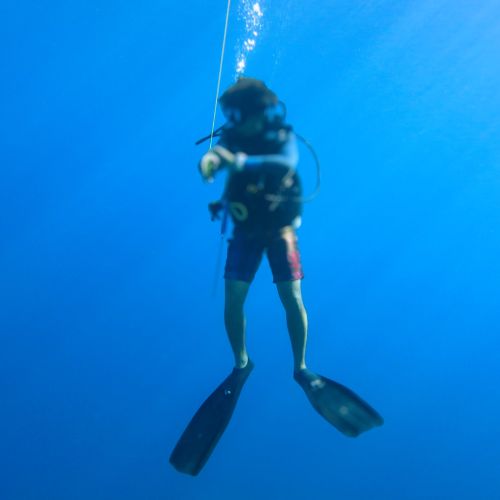Buoyancy: Science of Floating and SCUBA Diver’s
When an object is submerged in a liquid-filled container, the level of the liquid rises. This intriguing phenomenon occurs because the object displaces the liquid, pushing it out of the way. Before the object come into contact with the liquid, it exits in a state of equilibrium, with the weight of the liquid above being balanced by an upward force called up-thrust.
However, once the object is partially immersed, the up-thrust, which was previously opposed to the weight of the displaced water, starts acting on the object itself. Consequently, objects submerged in liquids appear to weigh less due to this buoyant force. This fascinating relationship between the amount of liquid displaced and the resulting up-thrust is known as Archimedes’ Principle, which
states:
“when an object is wholly or partially immersed in a liquid, the up-thrust it receives is equal to the weight of the liquid displaced.”

Buoyancy plays a crucial role in determining whether an object floats or sinks in a liquid. The relative magnitudes of weight and up-thrust determine the outcome, leading to three possible scenarios.
- Negative Buoyancy: when the weight of an object is greater than the up-thrust it experiences (weight of the liquid displaced), the object sinks.
- Neutral Buoyancy: if the weight of an object equals the up-thrust, the remains in its current position without sinking or floating.
- Positive Buoyancy: when the weight of an object is less than the up-thrust, the object rises and floats. As it reaches the liquid’s surface, It emerges from the liquid, reducing the weight of the displaced liquid and, consequently, the up-thrust. Eventually, the reduced up-thrust balances the weight of the object, allowing it to float in a state of equilibrium.
Impact on Divers
Divers must consider the principles of buoyancy to ensure safe and controlled underwater experiences. Here are a few key aspects related to buoyancy concerning divers:
Ballast weight
Typically, a diver in the water is positively buoyant, meaning they tend to float. To achieve neutral or negative buoyancy when fully immersed, divers need to increase their weight by adding ballast weights. The amount of weight required varies based on factors such as equipment type, underclothing, and water density.

Divers should be slightly overweight by approximately a kilogram, considering that up to a kilogram of air may be consumed during a dive. Maintaining a slight negative buoyancy when leaving the surface with a fully vented buoyancy control system (BCS) and comfortably vented diving suit is crucial. Using excessive ballast weight to achieve negative buoyancy and relying on BCS or suit inflation to achieve neutral buoyancy at depth should be avoided.
Buoyancy Variation with Depth
A self-contained diver in a diving suit is buoyant due to the air present in their lungs, trapped air in the suit, and the inherent buoyancy of the breathing apparatus. To facilitate descent, the increasing water pressure compresses the air in the suit, reducing their displacement and making them more negatively buoyant. This compression enhances the speed of their descent.

Suit Inflation and the Dangers of Blow-Up
If a diver with slight negative buoyancy inflates their suit while on the bottom, they displace a greater volume of water without changing its weight. Eventually, when the weight of the displaced water exceeds the diver’s weight, positive buoyancy occurs, causing them to ascend rapidly to the surface.
During ascent, as the water pressure decreases, the air in the suit further expands, displacing more water and increasing the diver’s buoyancy, which accelerates their ascent. Divers can release air from the cuff or relief valve to deflate their suit, counteracting this tendency to surface.
Emergency Ascent
In emergencies, divers have two methods to increase buoyancy.
- Inflation of BCS (Buoyancy Control System) is the preferred method as it allows better control over the ascent. Divers can vent or add to the BCS to regulate the ascent rate as needed.
- Slipping the diver’s weight should only be considered a last resort. This method is challenging because expanding gas in the diver’s suit makes it difficult to control the ascent rate effectively.

Using suit inflation or BCS inflation to increase buoyancy and aid ascent should be avoided when possible to ensure safe diving practices.
Conclusion:
In conclusion, understanding Archimedes’ Principle and buoyancy is crucial for divers and anyone interested in the science of floating. By comprehending the relationship between weight, up-thrust, and the amount of liquid displaced, divers can control their buoyancy effectively, ensuring a safe and enjoyable diving experience.

